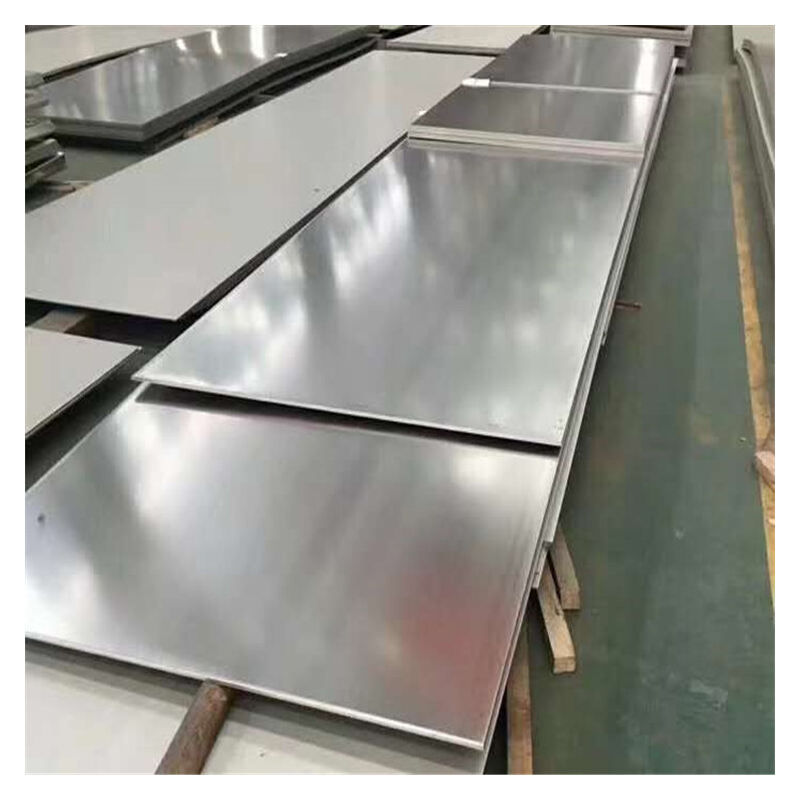Understanding the Properties of Stainless Steel Sheet
Composition and Corrosion Resistance of Stainless Steel Sheet
Stainless steel sheets are basically iron alloys with at least 10.5% chromium mixed in, plus some nickel, molybdenum, or carbon depending on what properties manufacturers want to boost. What makes these materials special is their ability to resist rust and corrosion naturally, which explains why they work so well in places where moisture or chemicals are always present. Think about kitchens where steam builds up constantly, or buildings near the ocean where salt air gets everywhere. The 304 grade works great for most kitchen equipment since it handles normal cooking conditions pretty well. But when things get really harsh like boats or seaside equipment, the 316 version becomes necessary because it has extra molybdenum that fights off saltwater damage much better than regular grades can manage.
The Role of Chromium Oxide Layer in Protecting Stainless Steel Surfaces
When chromium comes into contact with oxygen, it creates what's basically a microscopic shield on metal surfaces that stops them from getting rusty or stained. What makes this coating special is how it actually repairs itself when there's oxygen around, even if the surface gets scratched up a bit during normal use. But watch out for those harsh chemicals people often use around the house. Things like bleach or other strong acids can break down this protective film over time. That's why most experts recommend giving these surfaces a quick wipe down with mild soap and water at least once a week. Keeping that natural barrier intact means fewer problems down the road and saves money on expensive repairs later on.
Why Surface Finish Matters: Grain Structure and Polish Retention
When stainless steel sheets go through the rolling process, they develop what's called a directional grain pattern. To keep them looking good, it's best practice to clean along this grain direction since doing so helps prevent those tiny scratches from showing up and keeps the surface shiny. The brushed finish known as No. 4 is pretty forgiving when it comes to small marks and blemishes. But if someone wants that mirror-like shine, extra attention is definitely needed to maintain that glossy appearance over time. Cold rolled versions generally have much finer grain structures than their hot rolled counterparts, which makes them tougher overall despite being thinner in some cases.
Daily Cleaning and Care for Stainless Steel Sheets
Use Warm Water and Mild Detergent or Soap for Basic Cleaning
For routine maintenance, use warm water mixed with a pH-neutral dish soap or detergent. This combination removes contaminants without damaging the chromium oxide layer. Avoid solutions above 150°F (65°C), as high temperatures can accelerate oxidation in chloride-rich environments (Material Science Institute, 2022).
Cleaning in the Direction of the Grain for a Polished Finish
Wipe stainless steel sheets parallel to the grain using soft, damp cloths to avoid cross-grain scratches and reduce streaking. Circular motions increase scratch risks by 32% compared to linear wiping (Surface Engineering Journal, 2021), so consistent directional cleaning preserves both appearance and finish longevity.
Using Soft Cloths to Prevent Micro-Scratches
Choose gentle materials such as:
- Microfiber (60–80 g/m² density)
- Non-woven cellulose
- 100% cotton flannel
Test fabrics on inconspicuous edges first—low-quality textiles may leave lint or reactive fibers that degrade surface quality over time.
Rinsing and Drying Thoroughly to Prevent Water Spots
After cleaning:
- Rinse with deionized water
- Dry immediately with an absorbent chamois
- Buff with a clean, dry cloth
This process prevents mineral deposits from tap water, which cause 78% of persistent staining in residential settings (Water Quality Association, 2023).
Common Mistakes to Avoid When Handling Stainless Steel Sheets
Avoid Abrasive Sponges, Pads, or Cloths That Scratch the Surface
Steel wool, rough scrubbers, and abrasive tools create micro-scratches that trap moisture and dirt, accelerating corrosion. These imperfections disrupt the smooth surface and diminish reflectivity. For daily care, use non-abrasive options like microfiber cloths or nylon brushes designed for stainless steel.
Avoiding Harsh Chemicals and Chlorides That Compromise Protective Layers
Cleaners containing bleach, hydrochloric acid, or chlorides degrade the chromium oxide layer—the key defense against rust. Even brief exposure can initiate pitting corrosion, which spreads beneath the surface. Stick to pH-neutral detergents and rinse thoroughly after cleaning to preserve passivation.
Common Household Cleaners to Avoid When Handling Stainless Steel Sheets
Avoid these damaging products:
- Bleach or ammonia-based cleaners: React with chromium, causing discoloration
- Abrasive powdered cleaners: Scratch the surface and weaken corrosion resistance
- Glass cleaners with ammonia: Leave streaks and harm polished finishes
Instead, use dedicated stainless steel cleaners or mild dish soap diluted in warm water. For tough grime, a baking soda paste or diluted vinegar solution (1:3 with water) safely lifts buildup without harming the metal.
Specialized Cleaning Solutions for Tough Stains on Stainless Steel Sheet
Tackling Grease With Dish Soap for Kitchen-Grade Stainless Steel Sheets
To remove grease from kitchen surfaces, mix warm water with mild dish soap at a 1:10 ratio. Apply with a microfiber cloth, scrubbing along the grain to lift residue without damaging the polish. Rinse promptly with cold water to prevent film formation.
Removing Fingerprints With Glass Cleaners Without Ammonia Residue
Use alcohol-based glass cleaners to eliminate fingerprints without leaving ammonia-related streaks. Spray the product onto a soft cloth—not directly on the surface—and wipe in overlapping motions. This method maintains the chromium oxide layer while restoring shine.
Deep Cleaning With Baking Soda Paste for Stubborn Grime
For stubborn stains like coffee or oil marks, make a paste of baking soda and water (3:1 ratio). As noted in the 2024 Metal Care Report, this alkaline solution dissolves organic buildup without scratching. Apply with a nylon brush, let sit for 5–7 minutes, then rinse thoroughly.
Removing Limescale With White Vinegar Safely and Effectively
Treat hard water deposits by soaking a cloth in undiluted white vinegar and placing it over affected areas for 10–15 minutes. Acetic acid breaks down mineral scale gently. Follow with a baking soda rinse (1 tbsp per cup of water) to neutralize acidity, as recommended in industry maintenance guidelines.
Long-Term Maintenance and Protection of Stainless Steel Sheets
Addressing early signs of corrosion and rust on stainless steel surfaces
Inspect sheets monthly for discoloration or pitting, especially in coastal or high-humidity areas. Light surface rust can often be treated with a baking soda and water paste (1:3 ratio); persistent corrosion may require professional-grade stainless steel cleaners. Always scrub parallel to the grain to minimize visible damage.
Restoring the passivation layer after exposure to corrosive elements
Exposure to saltwater, chlorine, or acids can degrade the chromium oxide layer. Industry standards recommend citric acid passivation (10–20% concentration at 140–160°F) to restore protection. A 2023 corrosion prevention study found properly passivated sheets withstand three times longer chloride exposure than untreated ones.
Polishing stainless steel for shine and long-term protection
Apply non-abrasive, silicone-free polishes with microfiber applicators to maintain decorative finishes. Align polishing strokes with the grain, especially on brushed surfaces. In high-traffic architectural installations, quarterly polishing reduces microfracture risks by 40%, according to material durability benchmarks.
Creating a regular maintenance schedule based on environment and use
| Environment | Inspection Frequency | Key Tasks |
|---|---|---|
| Indoor/Dry | Biannually | Dust removal, visual inspection |
| Coastal/High-Salt | Monthly | Chloride removal, passivation check |
| Industrial | Quarterly | Acid contamination test, polishing |
Protective coatings and sealants to enhance durability
Food-grade wax coatings (melting point >180°F) offer temporary protection for kitchen-grade stainless steel. For outdoor use, architectural sealants with UV inhibitors help prevent oxidation. In critical applications, electroplated nickel layers have been shown in accelerated aging tests to double the lifespan of stainless steel sheets in corrosive environments.
Frequently Asked Questions (FAQ)
What causes stainless steel sheets to corrode?
Stainless steel sheets can corrode due to exposure to harsh chemicals, chlorides, or high humidity conditions that compromise the chromium oxide layer.
How often should stainless steel surfaces be inspected?
The inspection frequency depends on the environment. Coastal or high-salt environments require monthly inspections, while indoor or dry environments can be inspected biannually.
Can I use vinegar to clean stainless steel?
Yes, vinegar can be safely used for cleaning hard water deposits and limescale. Ensure to rinse well with water after using vinegar to neutralize any remaining acidity.
Table of Contents
- Understanding the Properties of Stainless Steel Sheet
- Daily Cleaning and Care for Stainless Steel Sheets
- Common Mistakes to Avoid When Handling Stainless Steel Sheets
- Specialized Cleaning Solutions for Tough Stains on Stainless Steel Sheet
-
Long-Term Maintenance and Protection of Stainless Steel Sheets
- Addressing early signs of corrosion and rust on stainless steel surfaces
- Restoring the passivation layer after exposure to corrosive elements
- Polishing stainless steel for shine and long-term protection
- Creating a regular maintenance schedule based on environment and use
- Protective coatings and sealants to enhance durability
- Frequently Asked Questions (FAQ)

